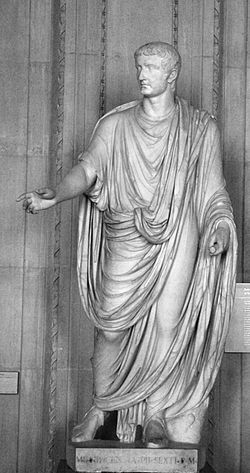Clothing in ancient Rome
Clothing in Ancient Rome is most commonly known by the toga and stola. The cloth was made from wool, linen or hemp. Cotton and silk were also used, more rarely. Leather was also used. The kind of clothing showed status.
Types
- The toga was an important item and was worn by only Roman citizens, and after the second century BC, only by men. After that, the only females to wear togas were prostitutes. The colors of togas had meaning. A toga could be edged with purple (high rank), or be all dark for mourning. Only emperors could wear entirely purple togas. In other words, clothing reflected status as well as practical needs. A red lined Toga often showed shame and disgrace, often worn when banished or before an execution.
- The palla was a mantle or headcloth worn by women with the stola. It draped over the shoulders and round the body.
- The Stola was a floor-length dress with long sleeves. It was worn over a tunic. The Stola was a symbol of marriage in ancient Rome times. Girls wore a simple tunic, except when going to an evening event, when ankle-length tunics were worn.
Clothing In Ancient Rome Media
Statue of Livia Drusilla wearing a stola and palla
Marble statue of Mars from the Forum of Nerva, wearing a plumed Corinthian helmet and muscle cuirass, 2nd century AD
Roman statue of a Virgo Vestalis Maxima (Senior Vestal)
Statue of a Gallus priest, 2nd century, Musei Capitolini
Detail of a Paleochristian Roman mosaic from the basilica of Santa Pudenziana in Rome, c. 410 AD, depicting Saint Pudentiana
An elaborately-designed golden fibula (brooch) with the Latin inscription "VTERE FELIX" ("use [this] with luck"), late 3rd century AD, from the Osztropataka Vandal burial site
Other websites
![]() Media related to Ancient Roman fashion at Wikimedia Commons
Media related to Ancient Roman fashion at Wikimedia Commons





